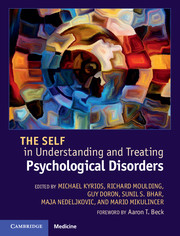Book contents
- The Self in Understanding and Treating Psychological Disorders
- The Self in Understanding and Treating Psychological Disorders
- Copyright page
- Contents
- Contributors
- Foreword
- Acknowledgments
- Section 1 Introduction and concepts
- Section 2 The self in treatment frameworks
- 4 Working with the future: a psychodynamic–integrative approach to treatment
- 5 Finding the self in a cognitive behavioral perspective
- 6 The self in acceptance and commitment therapy
- 7 The self in schema therapy
- Section 3 The self in specific psychological disorders
- Section 4 Conclusions and future directions
- Index
- References
4 - Working with the future: a psychodynamic–integrative approach to treatment
from Section 2 - The self in treatment frameworks
Published online by Cambridge University Press: 05 February 2016
- The Self in Understanding and Treating Psychological Disorders
- The Self in Understanding and Treating Psychological Disorders
- Copyright page
- Contents
- Contributors
- Foreword
- Acknowledgments
- Section 1 Introduction and concepts
- Section 2 The self in treatment frameworks
- 4 Working with the future: a psychodynamic–integrative approach to treatment
- 5 Finding the self in a cognitive behavioral perspective
- 6 The self in acceptance and commitment therapy
- 7 The self in schema therapy
- Section 3 The self in specific psychological disorders
- Section 4 Conclusions and future directions
- Index
- References
Information
- Type
- Chapter
- Information
- Publisher: Cambridge University PressPrint publication year: 2016
References
Accessibility standard: Unknown
Why this information is here
This section outlines the accessibility features of this content - including support for screen readers, full keyboard navigation and high-contrast display options. This may not be relevant for you.Accessibility Information
- 4
- Cited by
